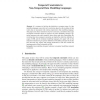Free Online Productivity Tools
i2Speak
i2Symbol
i2OCR
iTex2Img
iWeb2Print
iWeb2Shot
i2Type
iPdf2Split
iPdf2Merge
i2Bopomofo
i2Arabic
i2Style
i2Image
i2PDF
iLatex2Rtf
Sci2ools
ER
2008
Springer
2008
Springer
Temporal Constraints in Non-temporal Data Modelling Languages
It is common to find that the definition or common usage of a data modelling language causes there to be restrictions placed on the evolution of data values that are associated with schemas expressed in that modelling language. This paper terms these restrictions temporal constraints, and defines three types of temporal constraint which are argued to be useful modelling concepts, capturing important real-world semantics about objects and their relationships. By reviewing how these temporal constraints are implied by either the definition or usage of UML and the relational modelling languages, this paper will use the temporal constraints to give precise definitions of modelling concepts that to date have been left only vaguely and partially understood. It will also consider the implementation of these constraints in SQL.
Database | ER 2008 | Modelling Languages | Restrictions Temporal Constraints | Temporal Constraints |
| Added | 19 Oct 2010 |
| Updated | 19 Oct 2010 |
| Type | Conference |
| Year | 2008 |
| Where | ER |
| Authors | Peter McBrien |
Comments (0)

